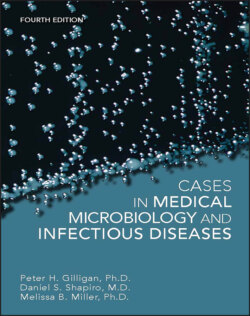Читать книгу Cases in Medical Microbiology and Infectious Diseases - Melissa B. Miller - Страница 28
Environmental and nutritional aspect of bacterial and fungal culture
ОглавлениеCertain basic strategies are used to recover bacterial and fungal pathogens. These strategies are dependent on the phenotypic characteristics of the organisms to be isolated and the presence of competing microbiota in a patient’s clinical specimen. Most human pathogens grow best at 37°C, human body temperature. Most bacterial and fungal cultures are performed, at least initially, at this temperature. Certain skin pathogens, such as dermatophytes and some Mycobacterium spp., grow better at 30°C. When seeking these organisms, cultures may be done at this lower temperature. A few clinically significant microorganisms will grow at low temperatures (4°C), while others prefer higher temperatures (42°C). These incubation temperatures may be used when attempting to recover a specific organism from specimens with a resident microbiota, such as feces, as few organisms other than the target organism can grow at these temperature extremes.
Another important characteristic of human bacterial and fungal pathogens is the impact of the presence of oxygen on the growth of these organisms. Microbes can be divided into three major groups based on their ability to grow in the presence of oxygen. Organisms that can only grow in the presence of oxygen are called aerobes. Fungi and many bacteria are aerobic organisms. Organisms that can only grow in the absence of oxygen are called anaerobes. The majority of bacteria that make up the resident microbiota of the gastrointestinal and female genital tracts are anaerobic organisms. Some bacteria can grow either in the presence or in the absence of oxygen. These organisms are called facultative organisms. A subgroup of facultative organisms is called microaerophiles. These organisms grow best in an atmosphere with reduced levels of oxygen. Campylobacter spp. and Helicobacter spp. are examples of microaerophiles.
Besides temperature and oxygen, nutrients are an important third factor in the growth of microbes. Many bacteria have very simple growth requirements. They require an energy and carbon source, such as glucose; a nitrogen source, which may be ammonium salts or amino acids; and trace amounts of salts and minerals, especially iron. Some human pathogens have much more complex growth requirements, needing certain vitamins or less well-defined nutrients such as animal serum. Organisms with highly complex growth requirements are often referred to as being fastidious. A fastidious bacterium that is frequently encountered clinically is Haemophilus influenzae. This bacterium requires both hemin, an iron-containing molecule, and NAD for growth.
